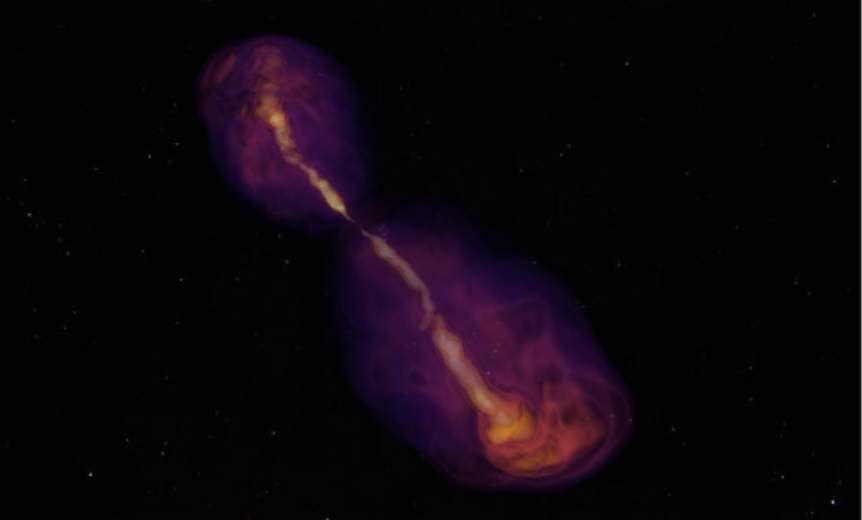Create a free profile to get unlimited access to exclusive videos, sweepstakes, and more!
Otherworldly blue lights in space are no longer shrouded in mystery
There are things weirder than aliens out there.

Flashes of blue lighting up the void sound like special effects in a sci-fi movie that almost certainly involves aliens, but what they actually are may be even more bizarre than that.
Strange phenomena can surround stars that go supernova when they collapse in on themselves. They aren’t the alien explosives that bombarded Earth (but still didn’t scare Bruce Campbell) in the 2005 SYFY (Formerly Sci Fi Channel) original movie Alien Apocalypse, but the blue ghosts seen in the wake of distant exploding stars have been a mystery. These glowing gobs of plasma are transients, or short-lived events, known as fast blue optical transients (FBOTs), whose almost paranormal color comes from their intense heat. Where they emerge from has remained unknown until now.
These cosmic wraiths are probably what happens when a star on its last breaths spews out jets of plasma that come from deep within its bowels and try to break free. When jets don’t make it all the way out, they transfer their energy into the cooling gas, or cocoon, that shrouds the stellar corpse. Astrophysicist Ore Gottlieb of Northwestern University, who led a study recently published in Monthly Notices of the Royal Astronomical Society, and his research team have created the first model that makes sense next to previous observations of FBOTs.
“The cocoon is generated by the interaction of a relativistic jet with a collapsing star — the head of the jet is trying to punch through the star, but the resistance from the massive stellar shells slows it down and results in spillage of jet material to form a cocoon,” he told SYFY WIRE.
Because Gottlieb wanted to find out whether the energy in the cocoon of a dying star matched that of an FBOT, he needed to see how powerful the jets were and how long they struggled inside the star before finally giving up. Jets form the cocoon as they propagate outwards at ridiculous speeds. Some will manage to blast their way out of the star, and will take a part of the cocoon with them. Those that remain trapped inside will burn energy attempting to make their way through all that gas, transferring power to the cocoon until they finally die.
Because the gamma-ray emissions of jets that shoot into space have already been observed, and the team had existing simulations of jets struggling to free themselves of their stars, they were able to come up with the cocoon energy, which is all the energy the jets use as they fight to get out. It looked exactly like what has been seen in FBOTs. The cocoon cools as it is being forced further out by a jet, and the heat released from that appears as an FBOT emission. These transients move much faster than the heavy gases in your average sluggish supernova.
“The entire star explodes in a supernova,” said Gottlieb. “In FBOTs, observations reveal that the amount of gas emitting optical radiation is just a fraction of a typical stellar mass, so mass ratio and the high energy allow the gas in FBOTs to reach significantly higher velocities.”
To get an idea of just how fast that is, gas velocities in a supernova reach thousands of miles per second, which is nothing compared to FBOT gas, which would zoom right past that at about 100,000 miles per second. High velocities and low mass had already been predicted in cocoons and are behind an FBOT’s extreme luminosity. FBOT will reach its absolute brightest moment when its gas, which starts off cloudy, turns transparent and emits maximum radiation. Supernova gas takes a much longer time for an observer to be able to see through it.
While the cocoon model that has started to demystify FBOTs doesn’t have a problem predicting optical light, an upgrade could more accurately predict X-ray and radio emissions coming from these anomalies. It could even go beyond that and predict neutrinos and cosmic rays that they are thought to release. Light trapped in a star that is almost dead can scatter into space and give off a short flash of gamma-ray, X-ray or UV emissions right when it comes through. Gottlieb wants to level up the model and capture the genesis of an FBOT in the future.
“The high energy of FBOTs and the dense environment inferred by observations in which they take place suggest they could be a source of high-energy neutrinos and cosmic rays,” he said. “Early signals may reveal information about the system from which FBOTs come from.”
So no, it isn’t aliens (again), but if anything could possibly be cooler than aliens, it’s phenomena like these.




























